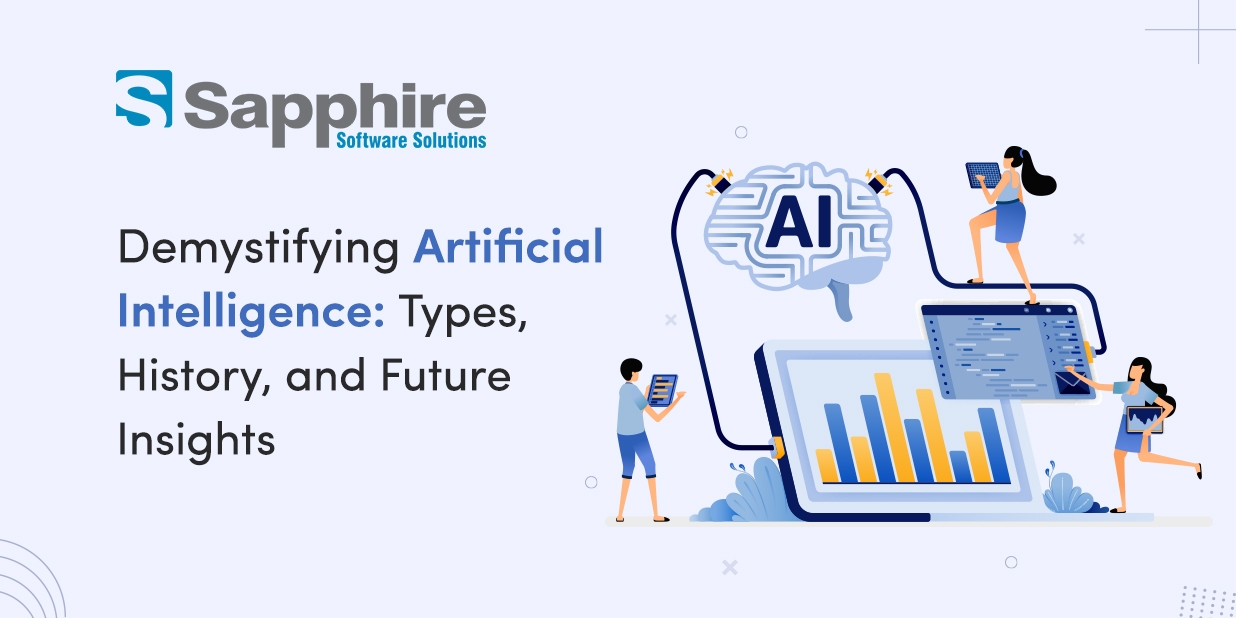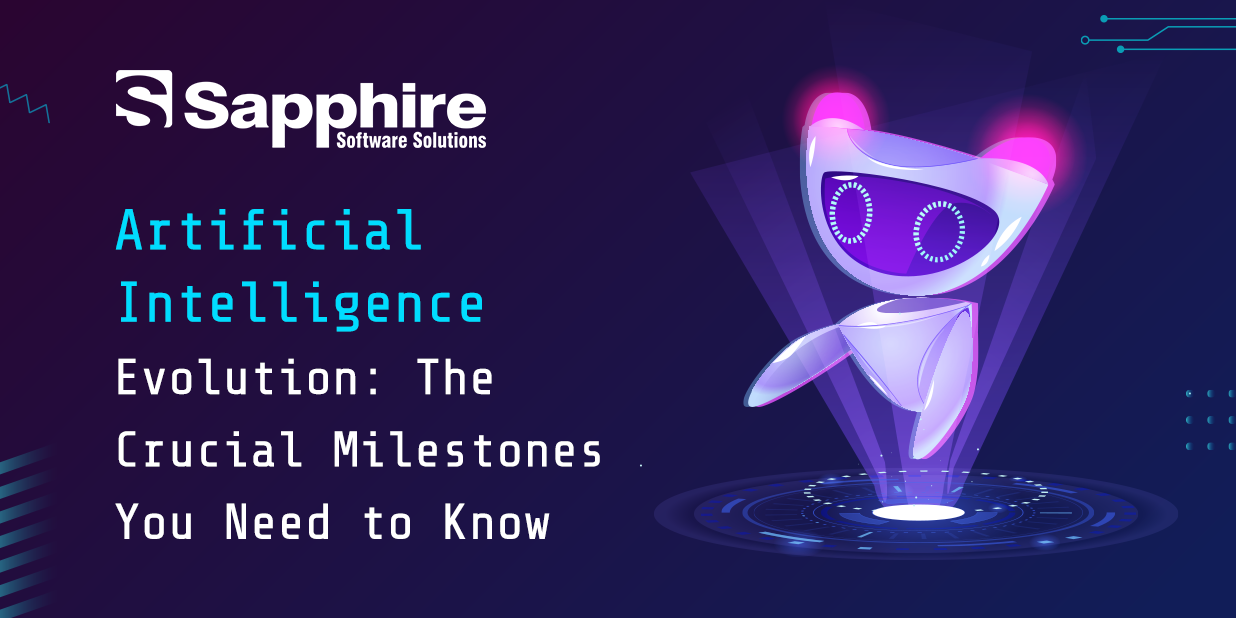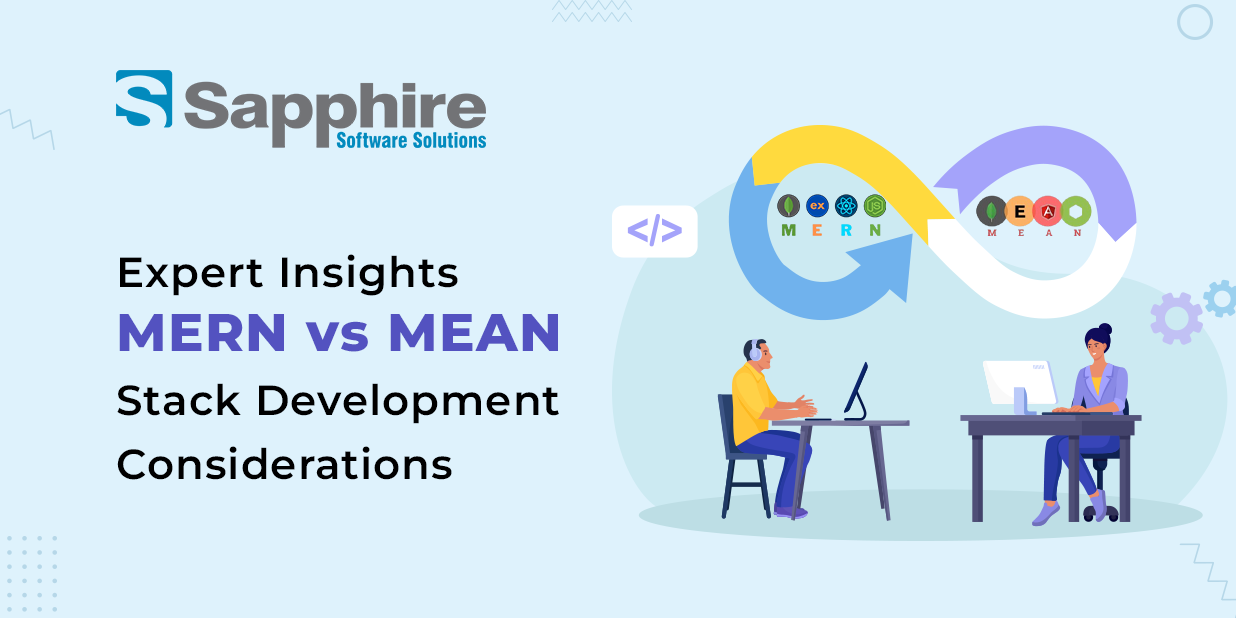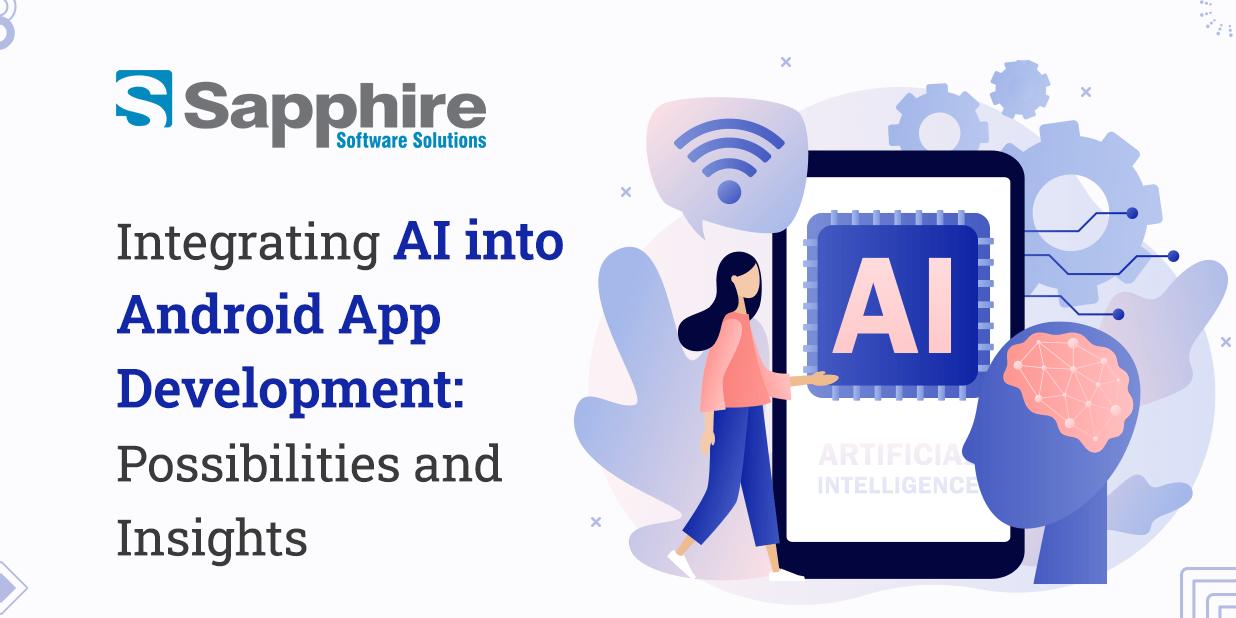AI has changed the way humans are interacting with technology. From using AI in day-to-day applications to using it to automate human tasks, this technology is reshaping this world. The forms, background, and potential applications of AI may be difficult to comprehend and are sometimes masked by myths. This blog seeks to demystify Artificial Intelligence by examining its many forms, chronicling its historical development, and providing insights into its potential applications in the future.
What is Artificial Intelligence?
The replication of human intelligence functions by machines, particularly computer systems, is known as artificial intelligence. Modern computer innovation is built on AI, unlocking value for consumers and companies. Let’s see different types of Artificial intelligence and some future insights.
Types of Artificial Intelligence:-
Based on its capabilities, Artificial intelligence development services may be divided into three primary groups: Narrow AI (Weak AI), General AI (Strong AI), and Superintelligence.
1. Narrow AI (Weak AI):
AI systems created and trained for a single task or a small range of tasks are called narrow AI systems. These systems are excellent at carrying out that specific task but cannot generalize outside their intended field. The most widely used kind of AI nowadays is narrow AI, which has several applications in different fields. Typical illustrations of Narrow AI include:
A. Virtual assistants: Virtual assistants like Siri, Alexa, Google Assistant, and Cortana are made to recognize and react to particular voice requests, provide information, make reminders, and carry out basic activities.
B. Speech and Image Recognition: AI systems can spot patterns, faces, and objects in pictures and videos. AI that recognizes speech can translate spoken words into text.
C. Recommendation Systems: Online services like Netflix, Amazon, and Spotify employ recommendation systems that AI drives to provide recommendations for content, goods, or music based on historical user behavior and interests.
D. Natural Language Processing (NLP): NLP AI systems can comprehend and interpret human language, which enables chatbots, sentiment analysis, and language translation.
E. Autonomous Vehicles: Self-driving vehicles use AI algorithms to navigate, understand their environment, and make quick judgments that ensure passenger safety.
Although very practical and helpful, narrow AI is constrained in its ability to comprehend context outside of its field.
2. General AI (Strong AI or Artificial General Intelligence – AGI):
General AI is an artificial intelligence (AI) system that resembles humans in terms of cognition and comprehension. This AI could comprehend, acquire, and apply information across various topics, akin to human intelligence, in contrast to Narrow AI, which is focused on specific activities.
3. Superintelligence:
A superintelligent AI system outperforms humans in every way. It would be an artificial intelligence (AI) creature with intellectual powers well over the sharpest human brains. If Superintelligence were to be attained, it might have the capacity to advance itself quickly, giving rise to the “recursive self-improvement” phenomenon.
Because of its potential to surpass and subjugate humans, the concept of Superintelligence sparks intense arguments and worries among scientists and decision-makers. A significant difficulty is ensuring the security and compatibility of Superintelligence with human values.
It’s crucial to remember that while Narrow AI is often used today and General AI and Superintelligence are still hypothetical, AI research and development are moving forward. The field may change in the future. Most applications of AI today fall under the category of narrow AI.
History and Future of Artificial Intelligence:-
“associate” refers to a group working together to solve a problem. Although the origins of AI may be found in ancient stories and philosophical ideas, the current age of AI only really started in the 20th century. Let’s examine the significant turning points in AI history:
Dartmouth Workshop and Early Concepts (1956):
When a group of researchers gathered in 1956 for the Dartmouth Workshop at Dartmouth College, including John McCarthy, Marvin Minsky, Allen Newell, and Herbert A. Simon, the phrase “Artificial Intelligence” was first used. Their objective was to investigate the viability of building artificial intelligence-simulating devices. The term “soap” refers to a term used to describe a product or service.
The Development of Symbolic AI (1956–1974):
“Symbolic AI,” which employed symbolic representations and logic-based reasoning to solve problems, was the focus of early AI research. To illustrate AI’s potential for resolving mathematical and logical issues, researchers constructed programs like the Logic Theorist (made by Newell and Simon) and the General Problem Solver (authored by Newell and Herbert A. Simon).
The AI Winter (1974-1980s):
Despite initial optimism, difficulties, and failures hampered AI development, resulting in the “AI Winter.” The original enthusiasm for AI’s promise had subsided, and there was a sharp decline in funding for research into the field. The limits of symbolic AI techniques, computing restrictions, and disappointed expectations caused the AI Winter.
In the 1980s and 1990s, expert systems and machine learning:
During the AI Winter, machine learning and expert systems were the main topics of AI research. Expert systems gained popularity and saw successful applications in industries like health and finance. These systems employed rule-based systems to simulate human competence in certain areas. Neural networks and decision trees are two machine learning algorithms significantly advanced during this time.
The AI Revolution and Deep Learning (2010s–present):
With the development of deep learning, a kind of machine learning that uses artificial neural networks with several layers, the 2010s represented a critical turning point in AI research. Convolutional and recurrent neural networks (CNNs) and other deep learning techniques, in particular, have transformed computer vision, natural language processing, and other AI applications.
Narrow AI Dominance:
Early in the 2020s, most AI applications will be narrow AI, focused on specific tasks like speech recognition, picture categorization, and language translation. Superintelligence and General AI (AGI) are still futuristic ideas that have not yet been achieved.
Future Insights and Ethical Considerations:-
The future of AI holds tremendous potential and raises several ethical considerations:
Future Insights:
1. Human-Machine Collaboration: The development of AI may lead to more human-machine cooperation. Instead of completely replacing professions, AI may improve human talents, creating new occupations that blend human creativity, emotional intelligence, and problem-solving ability.
2. Autonomous Systems and Robotics: Both fields are anticipated to progress rapidly. Autonomous vehicles, drones, delivery robots, and industrial automation will increase, possibly transforming logistics and transportation.
3. Personalized medicine: AI’s capacity to examine enormous amounts of information and find patterns has the potential to transform healthcare completely. Personalized medicine powered by AI may result in more precise diagnostics, tailored therapies, and drug development.
4. Natural Language Processing: Improvements in NLP will lead to more complex virtual assistants, language translation software, and sentiment analysis systems, enhancing cross-linguistic and cross-cultural communication and comprehension.
5. AI in Education: AI-powered adaptive learning systems can customize each student’s educational speed and material, boosting the learning process and raising academic results.
Ethical Considerations:
1. Bias and Fairness: AI systems that have been educated on skewed data might reinforce prejudice and bias that already exists in society. To prevent the reinforcement of negative biases, fairness, openness, and accountability must be ensured in AI systems.
2. Data security and privacy: AI often uses enormous volumes of individual data. Maintaining trust and preventing possible data abuse depends on safeguarding sensitive data and the privacy of persons.
3. Unemployment and Job Loss: The growing application of AI in automation might result in job losses in specific sectors. It will be vital to provide sufficient support and retraining programs and prepare the workforce for changes brought on by AI.
4. Algorithmic responsibility: Creating responsibility for algorithmic results is crucial as AI systems make crucial choices in various sectors. Users and stakeholders should understand precisely how AI choices are made.
5. Safety and Security: As AI gains strength, ensuring its security and thwarting nefarious usage is essential. A significant worry is preventing disastrous results by Superintelligence or improper AI.
6. AI in Weaponization: The development of autonomous weaponry and the possibility of AI-driven conflict pose moral concerns about handing over the responsibility for making life-or-death decisions to computers.
7. Ethical AI Research: Throughout the AI development process, researchers and developers must prioritize ethical issues. AI research conducted ethically should emphasize society’s benefits and adhere to human values.
Conclusion:
Since its start in the 1950s, Artificial Intelligence has advanced dramatically. AI’s evolution has been influenced by achievements and difficulties, from Narrow AI to the possibility of General AI and Superintelligence. The progress of artificial intelligence development company has been marked by cycles of excitement and pessimism, but recent developments in deep learning and machine learning have accelerated this process.
Exciting prospects for AI’s future include applications that will alter several sectors and tailored treatment enabled by AI. Thoughts of ethics, however, must be carefully and responsibly considered as society moves ahead. We can leverage AI’s potential to advance mankind while reducing hazards by assuring ethical AI development, considering possible socioeconomic effects, and establishing the necessary rules. As AI will continue to play a crucial part in forming our environment for years, demystifying AI is necessary to promote comprehension and cooperation.





































